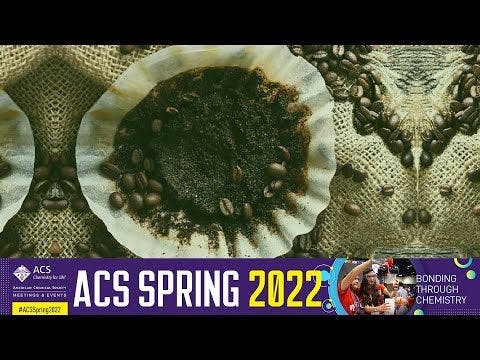Recent observations show that porous carbon—carbon that has unique geometric pores—could increase sensing speeds. The Ross Group at the University of Cincinnati turned to their love of coffee as a source of porous carbon. Coffee beans are a good carbon source.

Coffee grounds are a major component of biowaste. Making porous carbon suitable for electrochemical sensing is a useful way to recycle these castoffs from our morning brews. Brain activity is fast and can be measured using fast-scan cyclic voltammetry, an electrochemical technique that can measure activity as fast as 100 milliseconds. The typical electrodes for neuroscience sensing are fine carbon rods that are hard to make and require harsh chemicals. Recent observations show that porous carbon—carbon that has unique geometric pores—could increase sensing speeds.
The Ross Group at the University of Cincinnati turned to their love of coffee as a source of porous carbon. Coffee beans are a good carbon source. They are rich in cellulose and hemicellulose. After the members of the Ross Group enjoy their daily brew, they dry their coffee grounds, treat them with base (potassium hydroxide) to create porous carbon, and stabilize the porous carbon by drying it under nitrogen. The team then uses the porous carbon slurry to coat traditional electrodes. These coated electrodes trap analytes, such as dopamine, in holes in the surface coating. The trapped analytes interact longer with the electrode, which facilitates faster measurement of brain activity. Although principal investigator Ashley Ross admits that use of these electrodes in vivo is still a long way off, the work is promising, and her team has enjoyed the challenge of drinking enough coffee to keep them in starting materials.
Read the Full News Briefing
Video media briefing:
Explore Related Articles from ACS Publications Journals:
Sustainable Production of Novel Oleogels Valorizing Microbial Oil Rich in Carotenoids Derived from Spent Coffee Grounds
Aikaterini Mavria, Erminta Tsouko, Styliani Protonotariou, Aristeidis Papagiannopoulos, Maria Georgiadou, Dimitrios Selianitis, Stergios Pispas, Ioanna Mandala, and Apostolis A. Koutinas
DOI: 10.1021/acs.jafc.2c03478
Coffee Waste-Derived Nanoporous Carbons for Hydrogen Storage
Sebastian Stock, Nikolaos Kostoglou, Julian Selinger, Stefan Spirk, Christos Tampaxis, Georgia Charalambopoulou, Theodore Steriotis, Claus Rebholz, Christian Mitterer, and Oskar Paris
DOI: 10.1021/acsaem.2c01573
Coffee Grounds-Doped Alginate Porous Materials for Efficient Solar Steam Generation
Chaohu Xiao, Shanshan Wang, Yuping Guo, Yuhan Zhang, Qi-Meige Hasi, Qi Tian, and Lihua Chen
DOI: 10.1021/acs.langmuir.1c03102
Biomass-Derived Carbon for Electrode Fabrication in Microbial Fuel Cells: A Review
Wei Yang and Shaowei Chen
DOI: 10.1021/acs.iecr.0c00041
Coffee-Ground-Derived Nanoporous Carbon Anodes for Sodium-Ion Batteries with High Rate Performance and Cyclic Stability
Peng-Hsuan Chiang, Shih-Fu Liu, Yu-Hsuan Hung, Hsin Tseng, Chun-Han Guo, and Han-Yi Chen
DOI: 10.1021/acs.energyfuels.0c01105
Renewable Coffee Waste-Derived Porous Carbons as Anode Materials for High-Performance Sustainable Microbial Fuel Cells
Yu-Hsuan Hung, Tzu-Yin Liu, and Han-Yi Chen
DOI: 10.1021/acssuschemeng.9b02405
Coffee Waste-Derived Hierarchical Porous Carbon as a Highly Active and Durable Electrocatalyst for Electrochemical Energy Applications
Dong Young Chung, Yoon Jun Son, Ji Mun Yoo, Jin Soo Kang, Chi-Yeong Ahn, Subin Park, and Yung-Eun Sung
DOI: 10.1021/acsami.7b13799
Hierarchically Porous Carbon Nanosheets from Waste Coffee Grounds for Supercapacitors
Young Soo Yun, Min Hong Park, Sung Ju Hong, Min Eui Lee, Yung Woo Park, and Hyoung-Joon Jin
DOI: 10.1021/am5081919
Recent publications by this group:
Metal Nanoparticle Modified Carbon-Fiber Microelectrodes Enhance Adenosine Triphosphate Surface Interactions with Fast-Scan Cyclic Voltammetry
Yuxin Li, Alexandra L. Keller, Michael T. Cryan, and Ashley E. Ross
DOI: 10.1021/acsmeasuresciau.1c00026
Real-Time Detection of Melatonin Using Fast-Scan Cyclic Voltammetry
Austin L. Hensley, Adam R. Colley, and Ashley E. Ross
DOI: 10.1021/acs.analchem.8b01976
Porous Carbon Nanofiber-Modified Carbon Fiber Microelectrodes for Dopamine Detection
Blaise J. Ostertag, Michael T. Cryan, Joel M. Serrano, Guoliang Liu, and Ashley E. Ross
DOI: 10.1021/acsanm.1c03933
